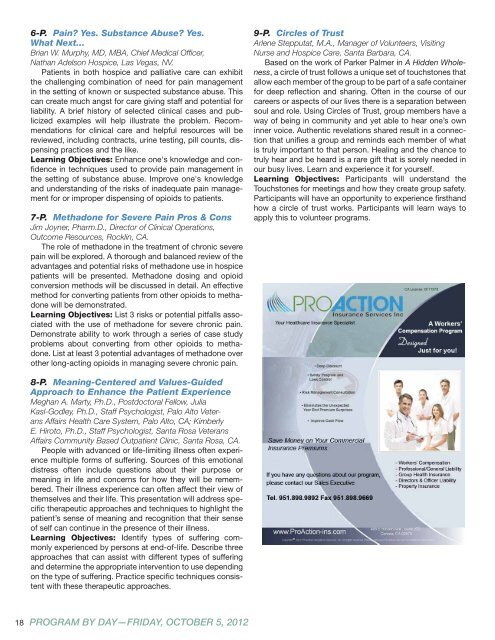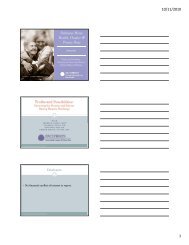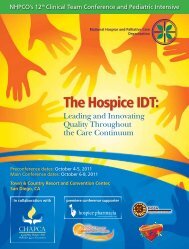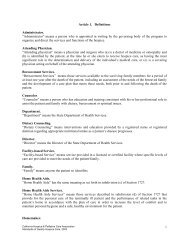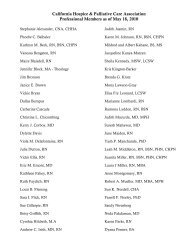FINAL PROGRAM - California State Hospice Association
FINAL PROGRAM - California State Hospice Association
FINAL PROGRAM - California State Hospice Association
You also want an ePaper? Increase the reach of your titles
YUMPU automatically turns print PDFs into web optimized ePapers that Google loves.
6-P. Pain? Yes. Substance Abuse? Yes.<br />
What Next...<br />
Brian W. Murphy, MD, MBA, Chief Medical Officer,<br />
Nathan Adelson <strong>Hospice</strong>, Las Vegas, NV.<br />
Patients in both hospice and palliative care can exhibit<br />
the challenging combination of need for pain management<br />
in the setting of known or suspected substance abuse. This<br />
can create much angst for care giving staff and potential for<br />
liability. A brief history of selected clinical cases and publicized<br />
examples will help illustrate the problem. Recommendations<br />
for clinical care and helpful resources will be<br />
reviewed, including contracts, urine testing, pill counts, dispensing<br />
practices and the like.<br />
Learning Objectives: Enhance one's knowledge and confidence<br />
in techniques used to provide pain management in<br />
the setting of substance abuse. Improve one's knowledge<br />
and understanding of the risks of inadequate pain management<br />
for or improper dispensing of opioids to patients.<br />
7-P. Methadone for Severe Pain Pros & Cons<br />
Jim Joyner, Pharm.D., Director of Clinical Operations,<br />
Outcome Resources, Rocklin, CA.<br />
The role of methadone in the treatment of chronic severe<br />
pain will be explored. A thorough and balanced review of the<br />
advantages and potential risks of methadone use in hospice<br />
patients will be presented. Methadone dosing and opioid<br />
conversion methods will be discussed in detail. An effective<br />
method for converting patients from other opioids to methadone<br />
will be demonstrated.<br />
Learning Objectives: List 3 risks or potential pitfalls associated<br />
with the use of methadone for severe chronic pain.<br />
Demonstrate ability to work through a series of case study<br />
problems about converting from other opioids to methadone.<br />
List at least 3 potential advantages of methadone over<br />
other long-acting opioids in managing severe chronic pain.<br />
9-P. Circles of Trust<br />
Arlene Stepputat, M.A., Manager of Volunteers, Visiting<br />
Nurse and <strong>Hospice</strong> Care, Santa Barbara, CA.<br />
Based on the work of Parker Palmer in A Hidden Wholeness,<br />
a circle of trust follows a unique set of touchstones that<br />
allow each member of the group to be part of a safe container<br />
for deep reflection and sharing. Often in the course of our<br />
careers or aspects of our lives there is a separation between<br />
soul and role. Using Circles of Trust, group members have a<br />
way of being in community and yet able to hear one’s own<br />
inner voice. Authentic revelations shared result in a connection<br />
that unifies a group and reminds each member of what<br />
is truly important to that person. Healing and the chance to<br />
truly hear and be heard is a rare gift that is sorely needed in<br />
our busy lives. Learn and experience it for yourself.<br />
Learning Objectives: Participants will understand the<br />
Touchstones for meetings and how they create group safety.<br />
Participants will have an opportunity to experience firsthand<br />
how a circle of trust works. Participants will learn ways to<br />
apply this to volunteer programs.<br />
8-P. Meaning-Centered and Values-Guided<br />
Approach to Enhance the Patient Experience<br />
Meghan A. Marty, Ph.D., Postdoctoral Fellow, Julia<br />
Kasl-Godley, Ph.D., Staff Psychologist, Palo Alto Veterans<br />
Affairs Health Care System, Palo Alto, CA; Kimberly<br />
E. Hiroto, Ph.D., Staff Psychologist, Santa Rosa Veterans<br />
Affairs Community Based Outpatient Clinic, Santa Rosa, CA.<br />
People with advanced or life-limiting illness often experience<br />
multiple forms of suffering. Sources of this emotional<br />
distress often include questions about their purpose or<br />
meaning in life and concerns for how they will be remembered.<br />
Their illness experience can often affect their view of<br />
themselves and their life. This presentation will address specific<br />
therapeutic approaches and techniques to highlight the<br />
patient’s sense of meaning and recognition that their sense<br />
of self can continue in the presence of their illness.<br />
Learning Objectives: Identify types of suffering commonly<br />
experienced by persons at end-of-life. Describe three<br />
approaches that can assist with different types of suffering<br />
and determine the appropriate intervention to use depending<br />
on the type of suffering. Practice specific techniques consistent<br />
with these therapeutic approaches.<br />
18 <strong>PROGRAM</strong> BY DAY—FRIDAY, OCTOBER 5, 2012


